|
The Blue Danube and the Viennese Waltz |
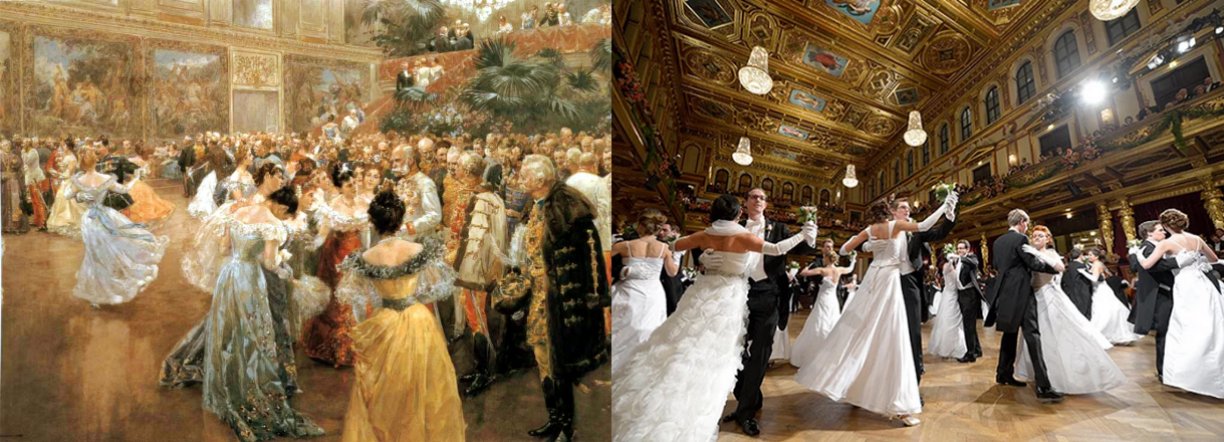 |
|
Artist Vladimir Pervuninsky |
| |
|
Rick
Archer's Note: These marvelous pictures
depicting the Era of the Viennese Waltz are the work of
talented artist
Vladimir Pervuninsky.
My hunch is that
Mr. Pervuninsky was actually painting the Imperial of Russia
rather than the Grand Ball of Austria. On the other
hand, since he now lives in Vienna, perhaps these paintings
are indeed the Austrian Grand Ball.
Fortunately, I
don't think it matters. His paintings are perfect.
I find
Mr.
Pervuninsky's
paintings to be glorious and inspiring.
I consider myself
blessed that this gentleman's vivid imagination has given me
such an exquisite picture of how the Grand Balls of the
Nineteenth Century must have appeared. I would loved
the chance to participate in an activity of such splendor.
Vladimir Pervuninsky was born in 1957 in the Russian
town of Chelyabinsk. Recognized at an early age for his
artistic talent, he went on to attend the Omsk
Pedological Institute, where he majored in painting and
graphics.
Vladimir, in search of a more focused and complete
training, set off for Moscow, where he was accepted into
the acclaimed V.I. Surikov Moscow State Art College.
There, he studied under the tutelage of the well-known
academician D.M. Mochalsky. While Vladimir, always, was
fascinated by Impressionism and Belle Epoque painting,
the strict curriculum of the Soviet Ministry of Culture
allowed no latitude for students or instructors to stray
from the state sanctioned style of Socialist Realism.
Despite these restrictions to his personal style,
Vladimir’s work flourished under the Soviet System and
he gained entry to the Union of Artists, the official
Soviet umbrella system. With the Union, he participated
in All-Union, Republic, and Moscow exhibitions, as well
as the Urals Exhibition in the town of Kurgan in 1992,
the exhibition "Landscape of Russia" in 1989, and the
"Memorials of the Motherland" exhibition of 1990-91.
During the dissolution of the Soviet Union, Vladimir
took advantage of the loosening regulations on travel
and went to Paris. There, he was exposed to a wider
variety and more expressive type of painting than he had
experienced in Russia.
Over
time, he incorporated a more gay, light Salon style to
his compositions, using the works of the La Belle Epoque
painters of the turn of the century for inspiration. His
work was very well received in Paris and throughout
Europe, and Vladimir began to exhibit and sell his
paintings in the annual Parisian art auctions at Arcole.
He now enjoys enormous popularity in Europe, and
particularly Vienna, where the artist resides.
Vladimir’s paintings executed in an Impressionist
manner, call to mind eras past. His paintings engage the
viewer in scenes from the last century, and transport
one to the streets of Old Moscow, the rivers cafes of
turn-of-the-century France, and the Grand Balls of
nineteenth century Vienna. His use of color and light
creates paintings of an unusual and rare beauty.
His works can be found in private collections throughout
Russia, Europe and America. His beautiful and engaging
compositions remain one of the more popular elements of
our gallery.
|
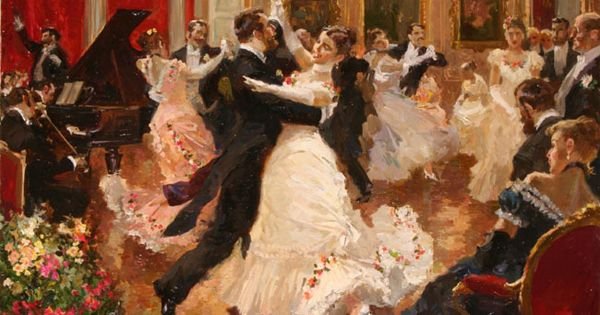
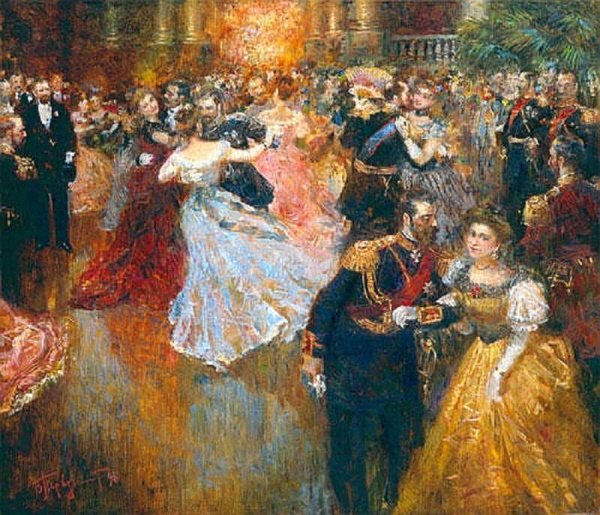
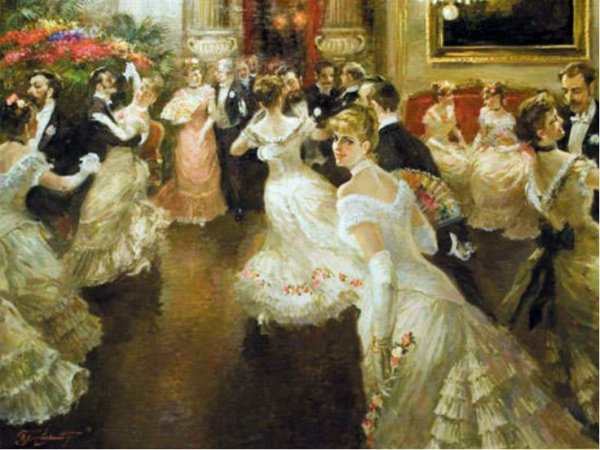 |
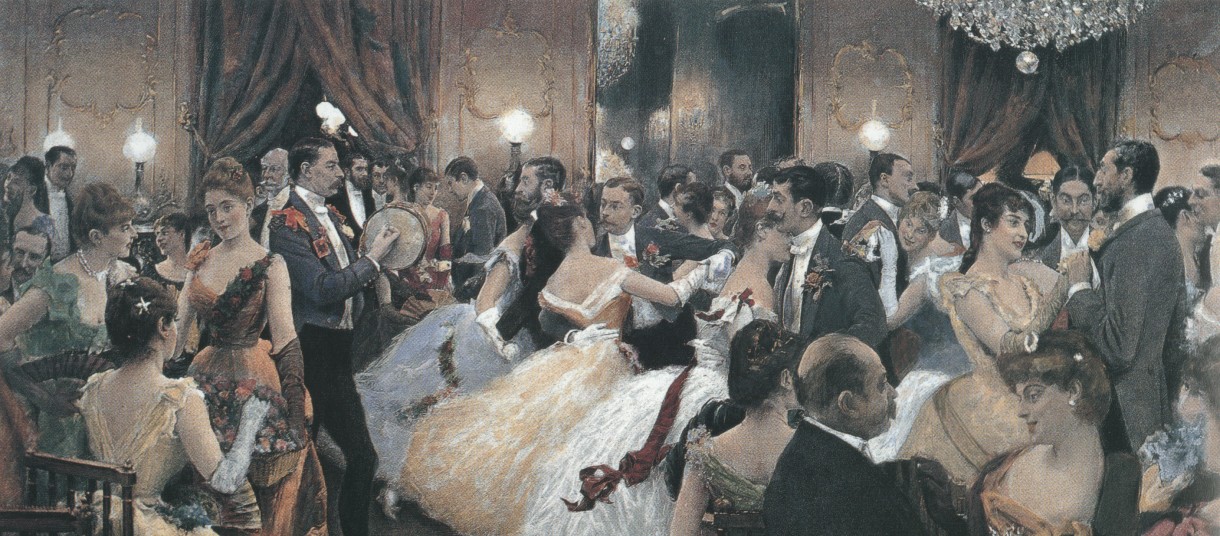 |
| |
History Of The Viennese Waltz
By Melanie
LaPatin (source)
The product of a more elegant age,
the Viennese Waltz was introduced in
Vienna in the early 1800s.
Immediately the dance was roundly
condemned in England.
The
Times of London
had this to say about the Prince
Regent's grand ball in 1816,
|
| |
|
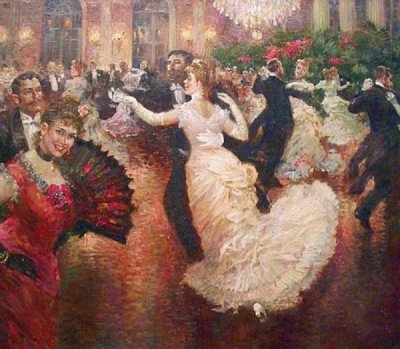 |
We remarked with pain that the
indecent foreign dance called
the Waltz was introduced (we
believe for the first time) at
the English court on Friday last.
It is quite sufficient to cast
one's eyes on the voluptuous
intertwining of the limbs and
close compressor on the bodies
in their dance, to see that it
is indeed far removed from the
modest reserve which has
hitherto been considered
distinctive of English females.
So long as this obscene display
was confined to prostitutes and
adulteresses, we did not think
it deserving of notice; but now
that it is attempted to be
forced on the respectable
classes of society by the civil
examples of their superiors, we
feel it a duty to warn every
parent against exposing his
daughter to so fatal a
contagion.
|
Of course, we now know such
condemnation did not deter the upper
crust from eventually indulging in
the Viennese Waltz.
The renowned German author Johann
Wolfgang von Goethe wrote,
Never have I moved so lightly. I
was no longer a human being. To
hold the most adorable creature
in one's arms and fly around
with her like the wind, so that
everything around us fades away.
When Lord Palmerston of England gave
the royal stamp of approval by
dancing the Viennese Waltz in
public, the rest of English Society
joined in for a brief spell.
That changed in 1914.
When World War I broke out, the
waltz orchestras left England due to
the fact that they were largely made
up of Austrian musicians.
Nothing of Germanic origin was in
vogue due to the war.
Consequently the Viennese
Waltz pretty much died out as
England and Germany battled each
other.
|
As the entire world joined in
the Great War, the last thing people
worried about was dancing. In
the few places where social dance
still existed, only the Slow Waltz
variation that had originated in
England continued beyond the
Austrian borders. The Viennese
Waltz would have to wait till the
end of World War II to make a
comeback.
Fortunately, over the next thirty years, Austria
kept this faster form of Waltz alive
as a folk dance.
After the end of the Second World
War, the original Viennese Waltz
made a resurgence. This when
the Viennese Waltz began to migrate
here to America.
In America, Dr. Lloyd Pappy Shaw,
who revived the Square Dance in the
early 1900s, wrote,
In close embrace, the dancers
turned continually while they
revolved around the room. There
were no steps forward or back,
no relief, it was all a
continuous whirl of pleasure for
those who could take it.
Today
the Viennese Waltz is accepted as one
of the staples of Ballroom dance.
The Viennese Waltz remains
essentially the same now as when
it was introduced two centuries ago.
The music continues to thrill.
Some of the greatest composers
have written truly beautiful
music to accommodate
the dancers. For this reason, the
Viennese Waltz echoes the glories and the
romance of a more genteel age.
This is a dance that
requires a great deal of stamina as
the dancers twirl constantly around
the floor at a dizzying pace. Although it takes a bit of
practice, the basic steps of Viennese Waltz can be mastered
easily enough. The major drawback is the rapid speed
of the music. Assuming one has the stamina to keep up, the
Viennese Waltz with its wonderfully
energetic swirling motion is a beautiful
and quite elegant dance to behold.
|
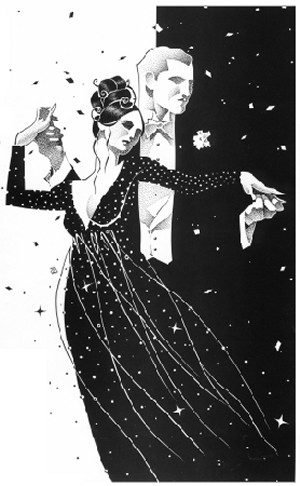 |
|
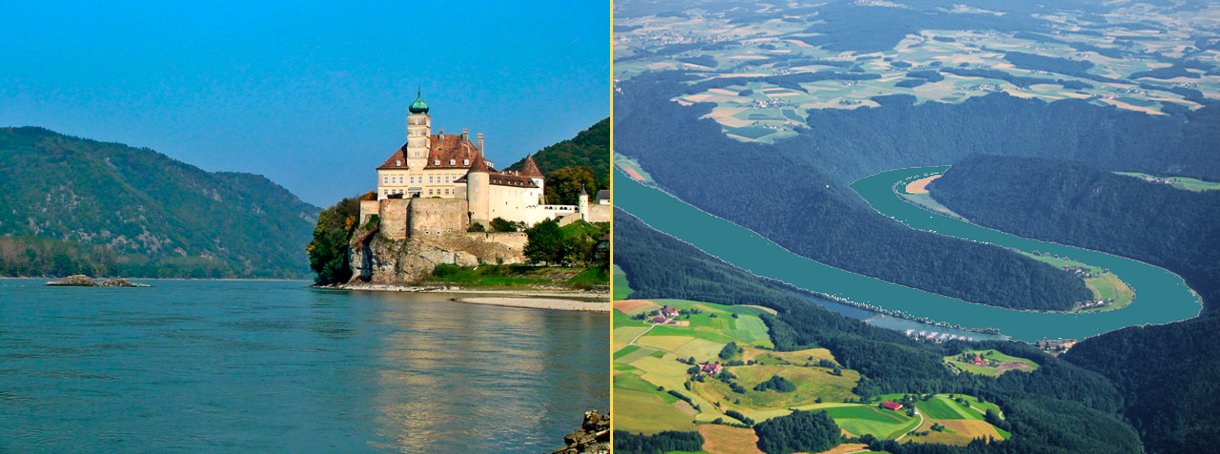
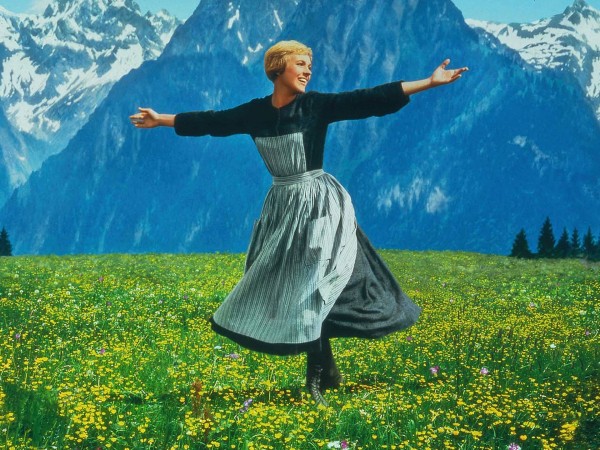 |
When people
think of Austria, they quickly think about the
Sound of Music as well as Amadeus,
the movie about Mozart.
The
beautiful Alps and
the
Danube River
come to mind as well.
For me, I always
think of the beautiful
Viennese Waltz.
As it turns out,
the Danube River plus a nasty Prussian guy
named Otto von Bismarck inadvertently helped to popularize
the Viennese Waltz.
It makes for a a
very interesting story that we will get to shortly.
However, first let's talk a bit about the Danube River.
In the case of
the fabled Danube River, it is the second longest river in
Europe after the Volga in Russia. The Danube starts in
the Black Forest mountains of southwestern Germany and flows
for some 1,770 miles (2,850 km) to its mouth on the Black
Sea.
Along its course
the Danube passes through 10 countries: Germany, Austria, Slovakia,
Hungary, Croatia, Serbia, Bulgaria, Romania, Moldova, and
Ukraine.
|
From the first recorded history, the Danube served as the northern border of
the Roman Empire. It was Romans on one side,
barbarians on the other.
Indeed, for
centuries the Danube has formed the boundary between
great empires. One need only look at its banks lined
with castles and fortresses to know the Danube has long
served an important military purpose. In addition, its
waters have served as a vital commercial highway between
nations.
Thanks in large
part to the natural beauty of the river, the
Danube's majesty has long been celebrated in romantic music.
|
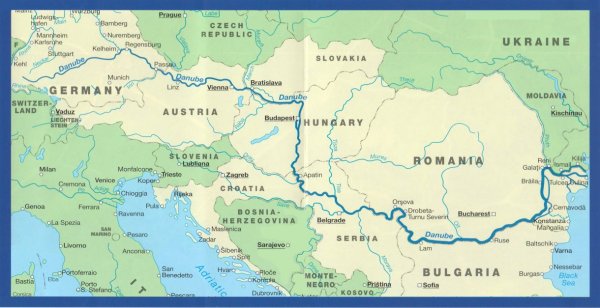 |
| |
|
No story about
the Blue Danube would be complete without a
look at Johann Strauss, the famous Austrian composer.
Strauss is best remembered for the Blue Danube,
but in his day he wrote many other classics such as the
Emperor's Waltz and Tales from the Vienna
Woods.
Indeed, Strauss
composed over 500 waltzes, polkas, quadrilles, and other
types of dance music, as well as several operettas and a
ballet for good measure. In his lifetime, Johann
Strauss became known known as "The Waltz King". He was
largely then responsible for the popularity of the waltz in
Vienna during the 19th century.
Johann Strauss
II (1825 – 1899) had to overcome considerable hardship to
begin his career. Born in Austria, it turns out that
his father, Johann Strauss I, was a well-established
composer. For whatever reason, the elder Strauss
forbade his son to attempt a career in music.
Nevertheless,
Strauss Junior studied the violin secretly as a child with
Franz Amon, the first violinist of his father's orchestra.
When his father discovered his son secretly practicing on a
violin one day, he gave him a severe whipping, saying that
he was going to beat the music out of the boy.
It was only when
the father abandoned his family for a mistress that his son
was able to concentrate fully on a career as a composer with
the support of his mother. No doubt his mother was
keen to see her talented son irritate her deserted husband.
And that is exactly what happened. Once the younger
man began to achieve success, an intense rivalry between
father and son developed.
The elder
Strauss' influence over the local entertainment
establishments meant that many of them were wary of offering
the younger Strauss a contract for fear of angering the
father. Finally in October 1844, Strauss Jr. was able
to persuade Dommayer's Casino, located in a suburb of
Vienna, to allow him to perform.
Dommayer's
Casino had been the site of many of his father's triumphs.
The elder Strauss, angry at his son's disobedience and at
the disloyalty of the proprietor, refused to ever play at
the Dommayer's Casino again. The feud was on.
The father blocked his son wherever he could.
|
 |
Vienna was
wracked by the revolutions of 1848 in the Austrian Empire.
Now the rivalry between father and son became much more
apparent. Johann Jr. decided to side with the
revolutionaries. It was a decision that was professionally
disadvantageous as the Austrian royalty snubbed him.
Meanwhile the
elder Strauss remained loyal to the monarchy and enjoyed
consideralbe patronage while his son struggled from lack of
work. Fortunately, fate intervened. The elder
Strauss died from scarlet fever in Vienna in 1849. Now
the younger Strauss merged both their orchestras and engaged
in further tours and took over all of his father's
engagements.
In particular,
Strauss Jr. learned to play politics. Franz Josef
ascended to the Austrian throne after the 1848 revolution.
By composing a number of patriotic marches dedicated to the
Habsburg Emperor Franz Josef I, the younger Strauss
ingratiated himself in the eyes of the new monarch.
Strauss Jr.
eventually surpassed his father's fame. He became one
of the most popular waltz composers of the era, extensively
touring Austria-Hungary, Poland, and Germany with his
orchestra.
|
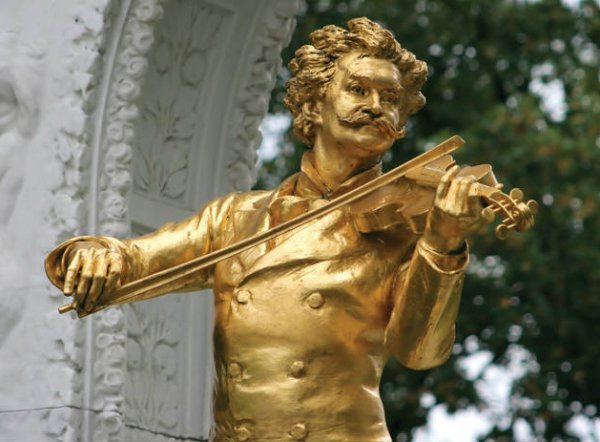 |
It must be hard
to imagine the most dangerous man in Europe played a key
role in the writing of the Blue Danube, but
Otto von Bismarck, prime minister of Prussia, did just that.
Bismarck was a
political genius who is considered the father of modern
Germany. In his day, Germany did not exist.
Where Germany stands today, this area was a Swiss cheese
conglomeration of 300 different territories and city-states
each with their own sovereign and their own armies.
Originally
Prussia was a small territory located in what is now the
corner of northeastern Poland. Through marriage,
Prussia gained ownership of the valuable Germanic territory
known as Brandenburg which contains Berlin. Around the
same time as the American Revolution in 1776, Frederick the
Great expanded Prussia's strength and territory
dramatically. That set the stage for Bismarck in the
following century.
When Bismarck
came to power in 1862, Prussia was strong, but at best the
fifth strongest European power behind England, France,
Spain, and Austria. Bismarck changed that in a hurry.
In the 1860s Bismarck engineered a series of wars that
unified the divided German states into a powerful German
Empire under Prussian leadership.
From this point
on, Bismarck skillfully used balance of power diplomacy to
preserve German dominance in a Europe which, despite many
disputes and war scares, remained at peace. It was
said that Bismarck remained the undisputed world champion at
the game of multilateral diplomatic chess for almost thirty
years. What a shame it was the Bismarck had to die.
Once he was
gone, Germany no longer had someone with the diplomatic
skills to keep Germany out of trouble. The powerful
nation Bismarck had built became Europe's bad boy of the
20th Century.
|
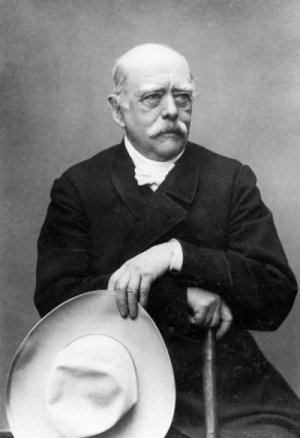 |
In European
politics, for every winner there is usually a loser.
It was Bismarck who caused the decline of the
Austro-Hungarian Empire.
Austria was more
powerful than Prussia. Austria was the dominant force
among the German-speaking territories. Prussia was its
main rival.
In 1866, Austria reneged on
a territory agreement.
Bismarck used this as an excuse to start a war
with Austria. Bismarck sent
Prussian troops to occupy Holstein. Provoked, Austria called
for the aid of other German states, who quickly became
involved in the Austro-Prussian War.
Unbeknownst to
Austria, Bismarck had made a secret alliance with
Italy, who desired Austrian-controlled Venetia
(Venice). Just when Austria
began to move northward to take on Prussia, Italy's
entry into the war forced the Austrians to divide their
forces. It was a master stroke on
Bismarck's part.
Meanwhile, thanks
to the work of Albrecht von Roon,
the Prussian army was nearly equal in numbers to the
Austrian army. With the
strategic genius of Roon and Chief of
Staff Moltke, the Prussian army
developed a new fighting technique known as
"Blitzkrieg" ("lightning war")
The war lasted seven weeks. Austria
had a seemingly powerful army that was allied with most of
the north German and all of the south German states.
Nevertheless, Prussia won the decisive Battle of
Königgrätz.
The King and his generals wanted to
push onward, conquer Bohemia and march to Vienna, but
Bismarck, worried that Prussian military luck might change
or that France might intervene on Austria's side,
insisted that Prussia quit while it was
ahead. Bismarck
insisted on a "soft peace" with no annexations and no
victory parades, so as to be able to quickly restore
friendly relations with Austria.
Nevertheless,
Austria was not only defeated, it was humiliated. The
damage was done. Mighty Austria would never be the
same again.
|
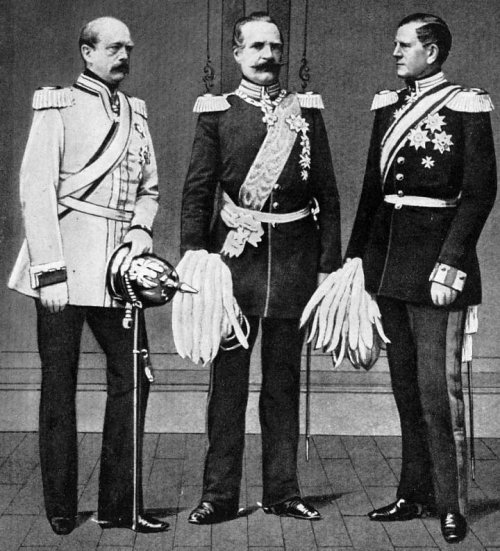
Bismarck with
Helmuth von Moltke,
Chief of Staff of the Prussian Army, and Albrecht von
Roon, Minister of War
|
|
The Story of the Blue Danube
|
 |
| |
|
|
|
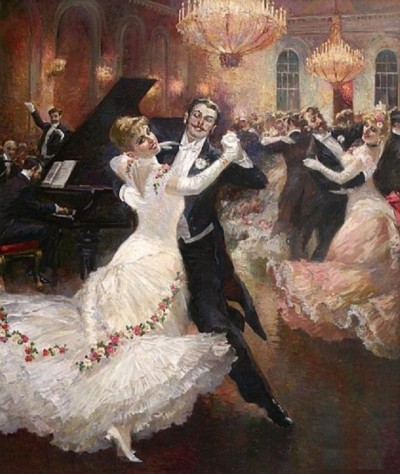
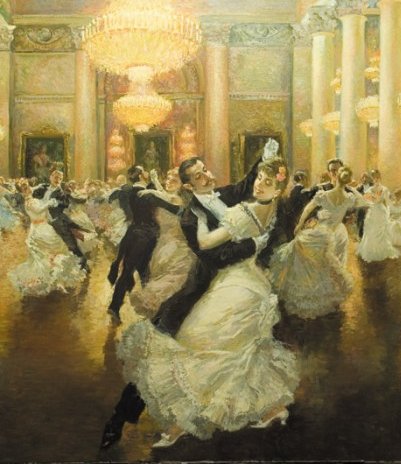 |
And now it is
time for the story of the Blue Danube.
Post-war Austria
was in disarray. Vienna was stunned by its defeat at
the hands of the upstart Prussia. Whatever could go
wrong, did go wrong.
To begin with, the Danube
flooded and damaged the outskirts of Vienna badly.
But that was nothing compared to the problems the war had
caused. In addition to losing considerable northern
territory to Prussia,
due to the secret Prussian-Italian
alliance,
Austria no longer had a port.
Thanks to that
scoundrel Bismarck, Italy had caught Austria totally
unprepared to defend its southern border against a surprise
attack. Gone was that pearl known
as Venice to Italy, Prussia’s ally.
Without a port, the Austrian
economy totally collapsed. Half
the people in Vienna were out of work.
Furthermore, the bitter defeat
signaled the end of Austrian influence as a
major world power. No longer
proud and haughty, Austria finally gave in and allowed
Hungary, a country it had dominated for centuries, to become
an uneasy yet equal partner in the new Austro-Hungarian
Empire.
The morale in Vienna was absolutely
the worst. The carnival festivities
were muted; the balls had none of their usual gaiety.
Meanwhile, Johann Strauss had
problems of his own... he was too
successful. In 1865, Johann Herbeck,
master of the Vienna Men’s Choral Society,
had commissioned Strauss to write
a choral work.
However,
shortly thereafter Strauss was
suddenly deluged with work that paid more money.
Due to these more lucrative offers,
Strauss put the Choral Society
piece on hold.
One year later following the horrible
defeat at the hands of the Prussians and the Italians,
in desperation, the choirmaster
revisited Strauss. He begged
him to write something cheerful… preferably a Waltz…. to
lift the spirits of the people.
Strauss was no longer nearly quite so
busy. The war had taken a toll on his commissions and
now he had some free time. Furthermore, he felt a
genuine tug on his sense of patriotism. Yes, indeed,
perhaps Austria could benefit for uplifting music.
By
coincidence, Strauss had just read a poem by Karl Beck.
Each stanza ended with the line: ‘By the
Danube, the beautiful blue Danube’.
Now Strauss had
both the inspiration and the title he needed for his new
work.
Only one problem... oddly
enough, at the moment the beautiful
blue Danube could
hardly be described as blue.
|
| |
|
It seems that ever
since the recent flood, the muddy Danube had been closer to
red-brown in color.
Nor did anyone in Vienna even like the
Danube River. All the Danube ever did was cause
problems. Not only was an entire season of crops
ruined by the flood, no one dared live anywhere near it.
Due to flooding
concerns, Viennese engineers avoided going anywhere
close to this
dangerous river.
Consequently, unlike Budapest,
Vienna's downstream neighbor, Vienna didn't want anything to
do with the massive river.
Therefore at
the time Strauss wrote his waltz,
the river didn’t even flow through Vienna.
It wasn’t until 1970 that
technology made it safe to finally allow
Vienna to expand to the banks of the Danube.
But Strauss
didn’t let small details like these deter
him. He took to to writing his uplifting song with great
passion. In1867,
Johann Strauss composed a Waltz titled An der schönen, blauen Donau.
|
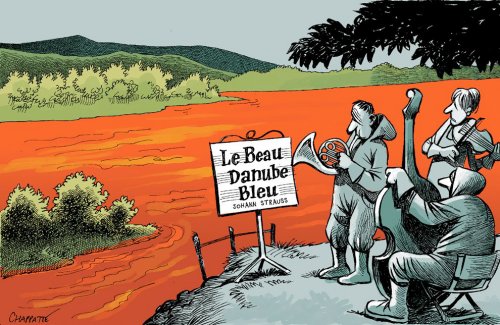 |
|
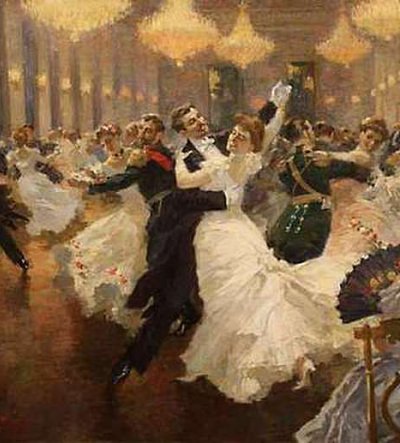
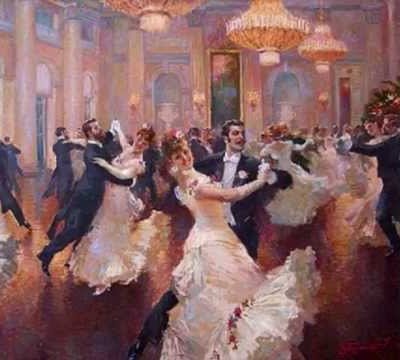 |
In time, On the
beautiful blue Danube would become the everylasting
symbol of imperial Vienna. However the song was not
even remotely an immediate hit. The song got off to a very
slow start.
To begin with, Strauss
didn't even bother debuting his song. Strauss was preoccupied
with his orchestra at the Hofburg fulfilling an obligation he had
made four years earlier. With Strauss out of town for a month,
an army band performed der blauen Donau instead to
little fanfare.
It didn't help that
Josef Weyl ruined the song. Weyl was an Austrian humorist
affiliated with the Choral
Society. Weyl
decided to add humorous
lyrics to the song.
“Wiener seid’s
froh! Oho! Wieso?” (“Viennese be happy! Oho!
But why?”).
Weyl's
satirical lyrics
ridiculed the lost war, the bankrupt city and
its politicians. The political bent to the song
left a lot to be
desired.
Due
to the scorn everyone felt for the hapless
military leaders who had let Grand Austria be
defeated on its home turf, it was
understandable why the people didn’t immediately warm to the
song.
Strauss had an idea. He
believed in his Waltz, but agreed the lyrics were
pure sabotage. So he debuted an orchestral version of his
song in Paris later in the year at the 1867
World Exhibition. Without the lyrics, the song
was greatly improved.
This time the reception
was electric. The Parisians and the visitors to
the World Exhibition absolutely loved the
song. Once the Parisians made such a fuss, now the
Austrians began to pay better attention.
With the lyrics removed, they too embraced the song. So did
the rest of the world. The song became a world-wide sensation.
When Johann Strauss made
his American debut in Boston on June 17, 1872, he conducted
The Blue Danube for the World Peace Jubilee.
For the occasion, Patrick Sarsfield
Gilmore, an Irish bandmaster, assembled an orchestra of 2,000 pieces
and a choir of 20,000. The experience was absolutely sublime.
The Blue Danube would go on to
become the most famous Waltz in the world.
German composer and pianist Johannes Brahms
was not only a close friend of Strauss, he was
also a fan of the piece. Years later
Strauss’s stepdaughter, Alice von Meyszner-Strauss, asked
Brahms to sign her autograph fan.
First Brahms wrote down the first bars of The Blue
Danube as a tribute
and then added a peculiar touch at the bottom.
“Leider nicht von Johannes Brahms”
What Brahms was trying to
say was “Alas,
this song was not written by
Johannes Brahms”. This was Brahms' way of
signaling his admiration for a magnificent song.
|
Trivia Question:
Without a doubt,
the Blue Danube
is the most famous song ever written about a river.
However, can
you name another famous song that
is also a Waltz and also refers to a river? I
will offer the answer shortly.
|
|
Final Thoughts about The Blue
Danube |
| |
Rick’s Note:
Strangely enough,
the new-found popularity of the Blue Danube
coincided with a distinct upturn in the fortunes of Austria.
It turned out that the elevated alliance with Hungary
produced something of an economic miracle.
For the next six
years, the harmony between the two countries translated into
bumper crops and astonishing prosperity. Noting that
the appearance of the Blue Danube coincided
with the upturn in fortune, the Austrian people embraced
their song warmly. From that point on, the
Viennese sentiment associated
with the Strauss melody has made
The Blue Danube the
unofficial Austrian national anthem.
Today the
waltz is traditionally broadcast by all public-law
television and radio stations exactly at midnight on New
Year’s Eve, and on New Year’s Day it is a customary encore
piece at the annual Vienna New Year’s Concert.
I know a funny
story about the Austrian tradition of playing Blue
Danube on New Year's Eve. One night I
mentioned to my Waltz dance class that I was burned out on
Christmas music.
It was December 2009 and I was
complaining to my Western Waltz class
just how sick and tired I was of hearing Christmas
music everywhere I went.
I told my class
that if I heard “It’s
a Holly Jolly Christmas” one more time, I thought I
would lose my mind!
A young man named
Steven was in my class. As he listened to my rant, I
noticed he was grinning.
Sure enough, I had struck a chord.
At break time, Steven came up to me. He laughed
about my Christmas music complaint and said he once had a
similar experience. Steven said that back when he was a
high school student, he had lived
in Austria for a year as an exchange student. He could have
sworn that the Blue Danube was the national
anthem.
Steven said that
everywhere he went… grocery store, restaurant, shopping
mall, coffee shop… they played the Blue Danube
over and over and over again. In just a matter of months,
he was already sick of hearing it.
Steven said
that New Year’s Eve was the worst. As he and his
girlfriend walked the snowy streets of Linz,
an Austrian city on the banks of the
Danube, it felt like someone was playing the song on
both sides of the street wherever they went.
Steven said it was so bad that he
couldn't take it any more. Losing all patience,
he suddenly began screaming
to stop it already! Then he ran
home with his bewildered Austrian
girlfriend in tow just to get away from the song.
Steven said he played Led Zeppelin music for two solid hours
trying to get that song out of his
mind.
Steven was a
very good Twostep dancer.
However, Steven said he had never learned to Waltz as a
form of protest against his hated song.
Then he heard about “Western Waltz” and decided he was just
being silly. What could be less Blue Danube
than a Western Waltz sung by George
Strait?
At this point,
Steven excused himself to use the restroom.
At this point I went to the DJ
booth and got my CD copy of famous
Viennese Waltzes. When we started the
second part of our class, I had my assistant Katrina
innocently ask Steven to help her demonstrate our
Waltz move from the previous hour. Then with everyone
watching, I shocked Steven by playing the Blue Danube.
Poor Steven turned purple. Everyone was in on the joke and
had a good laugh. To my relief, my
friend Steven somehow managed to
smile a little.
From that point on, I started every
class with a slowed-down version of Blue Danube.
It became our theme song. Steven didn't mind because
he had become ridiculously popular thanks to my goofy joke.
Every week, some pretty girl would go
up to Steven and ask him to tell his story again. Next
thing he knew, Steven and the girl would be dancing.... and
that is how he met his next girlfriend. Romance sure
works in funny ways.
|

| |
|
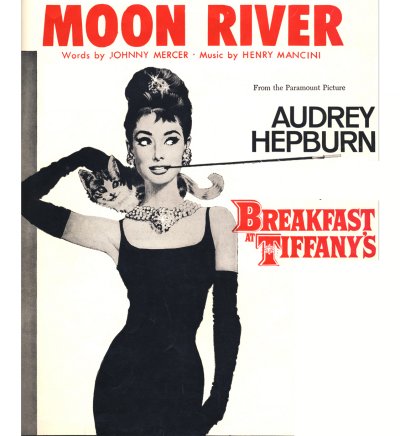 |
Trivia Question: Another Waltz
about a river….Did you name Moon River?
If so, I’m impressed! Go to the head
of the class.
This very beautiful song has seen many
different arrangements, but the version sung by Andy
Williams is a Slow Waltz.
Moon River was composed
by Henry Mancini with lyrics written by Johnny Mercer.
It received an Academy Award for Best
Original Song for its first performance by Audrey Hepburn in
the 1961 movie Breakfast at Tiffany's.
It became the theme song for Andy
Williams, who first recorded it in 1961 and performed it at
the Academy Awards ceremonies in 1962.
|
|
|